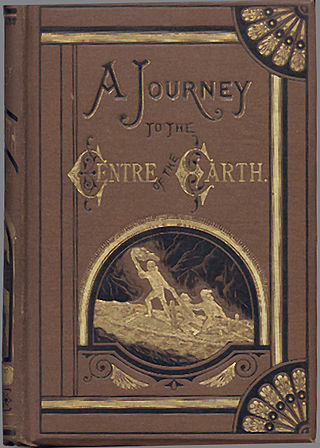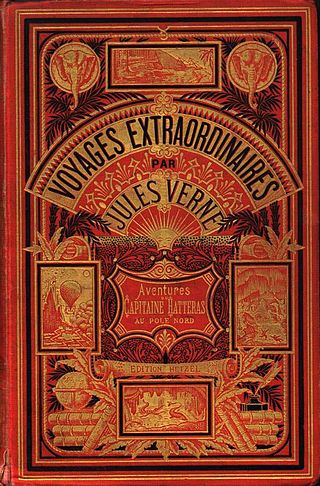
Jules Gabriel Verne was a French novelist, poet, and playwright. His collaboration with the publisher Pierre-Jules Hetzel led to the creation of the Voyages extraordinaires, a series of bestselling adventure novels including Journey to the Center of the Earth (1864), Twenty Thousand Leagues Under the Seas (1870), and Around the World in Eighty Days (1872). His novels, always well-researched according to the scientific knowledge then available, are generally set in the second half of the 19th century, taking into account the technological advances of the time.

Twenty Thousand Leagues Under the Seas is a science fiction adventure novel by the French writer Jules Verne. It is often considered a classic within both its genres and world literature. The novel was originally serialised from March 1869 to June 1870 in Pierre-Jules Hetzel's French fortnightly periodical, the Magasin d'éducation et de récréation. A deluxe octavo edition, published by Hetzel in November 1871, included 111 illustrations by Alphonse de Neuville and Édouard Riou.

From the Earth to the Moon: A Direct Route in 97 Hours, 20 Minutes is an 1865 novel by Jules Verne. It tells the story of the Baltimore Gun Club, a post-American Civil War society of weapons enthusiasts, and their attempts to build an enormous Columbiad space gun and launch three people – the Gun Club's president, his Philadelphian armor-making rival, and a French poet – in a projectile with the goal of a Moon landing. Five years later, Verne wrote a sequel called Around the Moon.

Geir Aule Jenssen is a Norwegian electronic musician and composer who records as Biosphere. A resident of Tromsø within the Arctic Circle, Jenssen is well known for ambient and ambient house pieces, often inspired by Arctic or mountain settings, and his use of loops and peculiar samples from science fiction and natural sources. His 1997 album Substrata was voted by the users of the Hyperreal.org website in 2001 as the best all-time classic ambient album. He has also composed several film scores.

Journey to the Center of the Earth, also translated with the variant titles A Journey to the Centre of the Earth and A Journey into the Interior of the Earth, is a classic science fiction novel by Jules Verne. It was first published in French in 1864, then reissued in 1867 in a revised and expanded edition. Professor Otto Lidenbrock is the tale's central figure, an eccentric German scientist who believes there are volcanic tubes that reach to the very center of the earth. He, his nephew Axel, and their Icelandic guide Hans rappel into Iceland's celebrated inactive volcano Snæfellsjökull, then contend with many dangers, including cave-ins, subpolar tornadoes, an underground ocean, and living prehistoric creatures from the Mesozoic and Cenozoic eras. Eventually the three explorers are spewed back to the surface by an active volcano, Stromboli, located in southern Italy.

The Jules Verne Trophy is a prize for the fastest circumnavigation of the world by any type of yacht with no restrictions on the size of the crew provided the vessel has registered with the organization and paid an entry fee. A vessel holding the Jules Verne trophy will not necessarily hold the absolute round the world record. The trophy was first awarded to the first yacht which sailed around the world in less than 80 days. The name of the award is a reference to the Jules Verne novel Around the World in Eighty Days in which Phileas Fogg traverses the planet in 80 days. The current holder is IDEC Sport skippered by Francis Joyon in 40 days 23 hours 30 minutes 30 seconds.

The Voyages extraordinaires is a collection or sequence of novels and short stories by the French writer Jules Verne.
In astrodynamics, orbital station-keeping is keeping a spacecraft at a fixed distance from another spacecraft or celestial body. It requires a series of orbital maneuvers made with thruster burns to keep the active craft in the same orbit as its target. For many low Earth orbit satellites, the effects of non-Keplerian forces, i.e. the deviations of the gravitational force of the Earth from that of a homogeneous sphere, gravitational forces from Sun/Moon, solar radiation pressure and air drag, must be counteracted. For spacecraft in a halo orbit around a Lagrange point, station-keeping is even more fundamental, as such an orbit is unstable; without an active control with thruster burns, the smallest deviation in position or velocity would result in the spacecraft leaving orbit completely.

A space gun, sometimes called a Verne gun because of its appearance in From the Earth to the Moon by Jules Verne, is a method of launching an object into space using a large gun- or cannon-like structure. Space guns could thus potentially provide a method of non-rocket spacelaunch. It has been conjectured that space guns could place satellites into Earth's orbit, and could also launch spacecraft beyond Earth's gravitational pull and into other parts of the Solar System by exceeding Earth's escape velocity of about 11.20 km/s. However, these speeds are too far into the hypersonic range for most practical propulsion systems and also would cause most objects to burn up due to aerodynamic heating or be torn apart by aerodynamic drag. Therefore, a more likely future use of space guns would be to launch objects into Low Earth orbit, at which point attached rockets could be fired or the objects could be "collected" by maneuverable orbiting satellites.

Voyage: Inspired by Jules Verne is a point-and-click adventure game with pre-rendered graphics, developed by Kheops Studio and published by The Adventure Company for the PC in 2005. The game's story focuses on a French adventurer's journey to the Moon in the 19th century, and the ancient lunar civilization he subsequently finds.
Science fiction opera is a subgenre of science fiction. It refers to operas whose subject-matter fits in the science fiction genre. Like science-fiction literature, science-fiction operas may be set in the future and involve spaceflight or alien invasion. Other science-fiction operas focus on a dystopian view of the future. Like Lorin Maazel's opera 1984, they may be based on a previously written science fiction book.

The columbiad was a large-caliber, smoothbore, muzzle-loading cannon able to fire heavy projectiles at both high and low trajectories. This feature enabled the columbiad to fire solid shot or shell to long ranges, making it an excellent seacoast defense weapon for its day. Invented by Colonel George Bomford, United States Army, in 1811, columbiads were used in United States seacoast defense from the War of 1812 until the early years of the 20th century. Very few columbiads were used outside of the U.S. and Confederate Armies; nevertheless, the columbiad is considered by some as the inspiration for the later shell-only cannons developed by Frenchman Henri-Joseph Paixhans some 30 years later.

Around the Moon, also translated as Circling the Moon and All Around the Moon, is the sequel to Jules Verne's 1865 novel, From the Earth to the Moon. It is a science fiction tale which continues the trip to the Moon that was only begun in the first novel. Later English editions sometimes combined the two under the title From the Earth to the Moon and Around It.

Michel Jeury was a French science fiction writer, reputed in the 1970s. He also used the pseudonym of Albert Higon.

Star Wars: Hyperspace Mountain is an indoor/outdoor steel roller coaster in Discoveryland at Disneyland Paris. Originally themed around Jules Verne's classic 1865 novel From the Earth to the Moon, the attraction first opened on June 1, 1995, three years after the park's debut in an attempt to draw more guests to the financially unstable European resort. Unlike other Space Mountain attractions at Disney theme parks, the installation at Disneyland Paris had a steampunk-detailed appearance with a Columbiad Cannon and a plate-and-rivet exterior under its previous theme. It is the only Space Mountain to feature inversions, a launch, a section of track that exits and re-enters the interior, and a synchronized on-Board audio track. It is by far the largest Space Mountain installation at any Disney theme park.

The Jules Verne ATV, or Automated Transfer Vehicle 1 (ATV-1), was a robotic cargo spacecraft launched by the European Space Agency (ESA). The ATV was named after the 19th-century French science-fiction author Jules Verne. It was launched on 9 March 2008 on a mission to supply the International Space Station (ISS) with propellant, water, air, and dry cargo. Jules Verne was the first of five Automated Transfer Vehicle spacecraft to be launched.

Le voyage dans la Lune is an 1875 opéra-féerie in four acts and 23 scenes by Jacques Offenbach. Loosely based on the 1865 novel From the Earth to the Moon by Jules Verne, its French libretto was by Albert Vanloo, Eugène Leterrier and Arnold Mortier. This was another prolific year for the composer, that included also the third version of Geneviève de Brabant, Les hannetons, La boulangère a des écus, La créole and a waltz for Tarte à la crême.

Amédée Victor Guillemin was a French science writer and a journalist.

The life and works of the French filmmaker Georges Méliès (1861–1938), including his famous short film A Trip to the Moon, have been referenced many times in creative works, including the following examples.

Jules Verne (1828–1905), the French writer best known for his Voyages extraordinaires series, has had a wide influence in both scientific and literary fields.


















